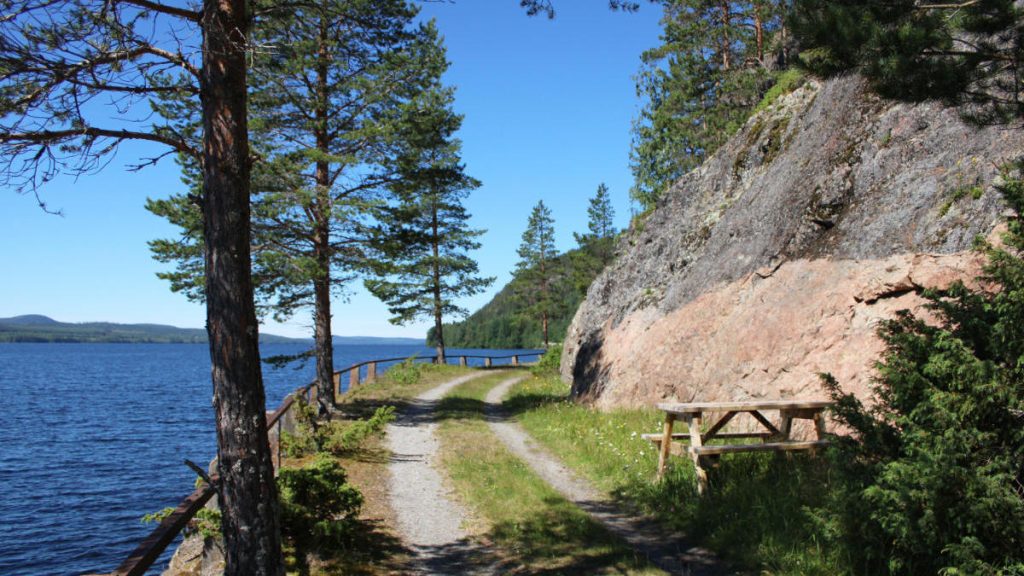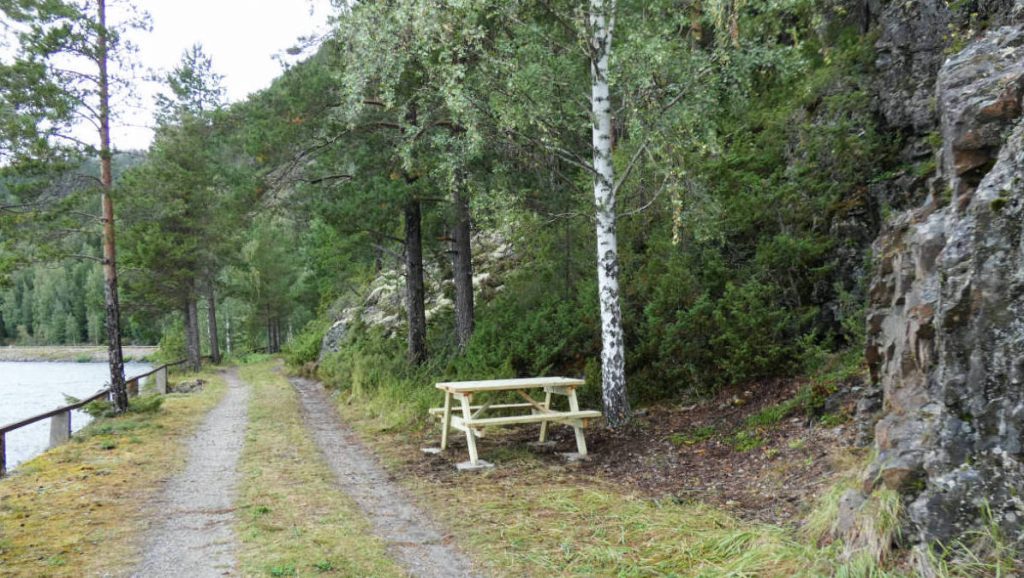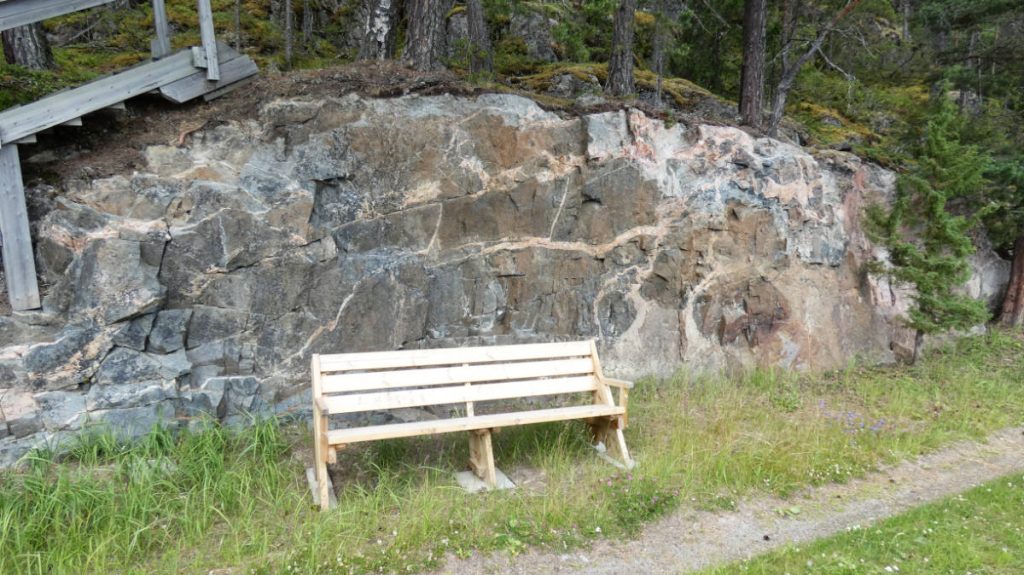Stadsberget
1,500 million year old magma chamber
Here you can look straight into a 1,500 million year old magma chamber, a bit like an enormous balloon. The chamber was formed of masses of molten rock, magmas that pushed upwards from deep within the earth and gathered a few kilometres below the earth´s surface. Since then all the material that had been above the chamber has weathered and eroded making it possible for you to look right into the chamber.
Masses of molten rock became red granite and dark gabbro
Two melts pushed their way up here from deep within the earth at the same time but separately. The magmas were of completely contrasting compositions and so behaved in different ways.
When in due course the magmas cooled and became solid they formed rocks. One of the magmas was dark, almost black and became gabbro. The other one was red in colour and became granite.

Pulses of magma filled the chamber
Pulses of warm magma were continuously adding to the magma chamber from below. Magma that had already solidified could then heat up and become liquid again. The magmas interacted in batches, forming different patterns depending on whether they were liquid at the same time or not. Gabbro and granite melt at different temperatures. Gabbro is several hundred degrees warmer when melted compared to granite. The difference in temperatures between the two magmas meant that they would not fully blend everywhere.

Magma mingling – "pillows" of gabbro in granite
In many places you can see patterns of the gabbro in the granite, looking like pillows. This is called magma mingling and occurred at the time when both magma types were partially liquid at the same time.
The magmas may have been cold, hot or tepid at the time of the encounters. Around the gabbro you can sometimes spot a darker outer edge; this appeared when the warmer gabbro cooled off quicker in contact with the colder granite.

Magmatic breccia – angular fragments of gabbro in granite
At times the gabbro magma had started to cool off or become hard before a new pulse of hot granite magma came pushing upwards. This would cause the gabbro to crack and break into angular fragments. This is called magmatic breccia.
In case the almost solid granite encountered a pulse of hot gabbro, the granite may have been a bit burned by the gabbro. This would be seen as a white edge around the granite.

Magma mixing - mixed magmas
When magma had the possibility to harden slowly it remained warm for longer and heated up its environment. Magmas of different compositions could blend and become solid at the same time. Crystals from one of the magmas could merge with another and eventually dissolve. A new rock was formed, a sort of hybrid rock. Hybrids contain minerals that in normal circumstances would not co-exist. The rocks can be difficult to see and identify since they can appear in so many different ways.

Weathering worns down rocks
Rock is continuously worn down by, for example, the sun, wind, and water, meaning that rock surfaces are in constant stage of change.
Here you can see traces of the weathering rock. In the border area where gabbro encounters granite you can see, in some places that the gabbro has abraded more than the granite. One reason for this difference is that the rocks contain minerals that weather more or less easily. Quartz is in general a mineral that does not weather easily.

Granite resistant to weathering
Granite contains much quartz which makes it more resistant to weathering compared to others such as gabbro. The exception is rapakivi granite where the texture and the fact that it contains a calcium-rich type of the mineral feldspar (plagioclase) which makes it more prone to weather.
Pegmatite – a species of rock with large crystals
In the rock wall you can also see oblong galleries or oval forms (glands) of the rock pegmatite. The rock is the last one to cool in a smelt of magma. Its crystals are large since they have had the time and the possibility to grow in the cracks in the rock where they cooled. Pegmatite is formed by quartz and feldspar but may also contain rare and odd minerals. The further towards the middle of the gallery or the gland the younger is the mineral.

Porphyry - a dark, younger rock matrix
Mt Stadsberget displays galleries of the rock porphyry. They were formed by magma of porphyry pushing its way here through cracks in the mountain. It was long after the magma chamber had formed, at a stage when the mountain had cooled and cracked. It is not clear when this happened. To determine the age of the porphyry, more detailed investigations need to be carried out.

Rapakivi granite – a rare granite that crumbles easily
The rapakivi granite is odd in appearance. Scientists have different theories for this but there is no consensus. The rock is most often meaty red with large crystals and a yellow-white shell. The colour of the crystals and the shell stems from two kinds of the mineral feldspar. The semi-transparent, grey grains are the mineral quartz.
Rapakivi granite is quite rare in Sweden and nowhere else in the country are you able to study the rock as well as in Ragunda.

Rapakivi means rotten or dirty stone
The word rapakivi is Finnish and refers to the two words ‘rapa’ meaning rotten or dirty, and ‘kivi’ that means stone or rock. The name refers to its character since rapakivi granite is easily worn down by water, wind and ice, it crumbles.
More information
Sites to visit on Theme Continental Drift
More site photos



Places to visit nearby
Practicalities
Accessibility
See Accessibility.
Activities
Stop for a break and enjoy the fine views over the Lake Gesunden and River Indalsälven. From the site riverside walk Krångede runs along Indalsälven and a hiking trail up on Mt Stadsberget, Stadsbergetleden. See also Activities in Ragunda.
Eating and drinking
The nearest grocery store, café and eatery are in Hammarstrand. See also Eating and drinking in Ragunda.
Accommodation
Missing on site, but various options are available nearby. See Accommodation in Ragunda.
Getting here
SWEREF 99 TM N: 7 001 302 E: 552 049
WGS84 N: 63,137270° E: 16,032453°



